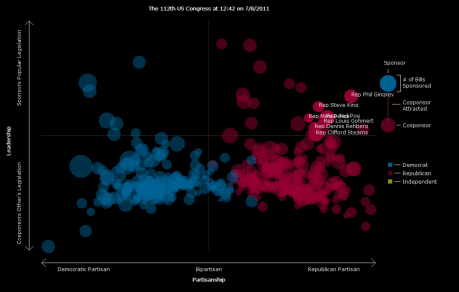As I mentioned in yesterday’s post, I was going to examine how Republican leadership in the house is something of a reflection of the pattern seen on the Democratic side, where the Progressive Caucus counts among it’s members every major Democratic legislative leader. I was too hasty in making this assumption, however. On the Republican side, the Tea Party Caucus in fact does not count the Republican legislative heavyweights among its ranks. Check out the image below (click for a larger image).
In the image above I’ve highlighted all the members of the Tea Party Caucus who show up above the mid-leadership line. As expected they are also all concentrated to the far right. While these few representatives have established themselves as leaders of a small, partisan portion of the House, the true legislative leaders within the party are not members of the Tea Party Caucus and have actually attracted quite a bit of bipartisan support with their legislation. Check this out:
The two legislative leaders, Eric Cantor and Jim Gerlach, have garnered large amounts of bipartisan support for their legislation. Because of this, they have risen to the top. Now, it’s important to remember that Republicans in the House should not need any Democratic support to pass legislation due to their significant majority. So why is this bipartisanship occuring? I have a few ideas.
First Idea: When in the majority, legislators will have more of a tendency to attract bipartisan support. If a bill is sponsored by the majority party it has a higher chance of passing. As such, Democrats may be clinging onto legislation that is likely to pass, contains some good ideas, and is not overly offensive to their base.
Second Idea: Due to divisions within the Republican party, it has become necessary for Republicans to deal with Democrats in order to pass some important legislation. For instance, the Tea Party, with its libertarian tendencies, has forced some close votes on what would have been relatively safe votes in the old GOP, such as the vote to extend the Patriot Act, which only passed with Democratic support.
Likely it’s some combination of these two ideas that is causing this bipartisan leadership pattern among Republicans, along with a dash of some other factors I’m missing. Ultimately, this indicates that leadership from a less moderate caucus is possible when your party is in the minority, but it is hard to lead from a partisan caucus while in the majority. As members of the majority, the legislative heavyweight are by the nature of their majority position likely to attract more bipartisan support. At the same time the broader diversity of ideologies within the majority party requires occasional bipartisan efforts in order to pass legislation.
The Tea Party may see value in their ideological, partisan pursuits, but that does not (and probably cannot) result in legislative leadership, especially from within the majority.


